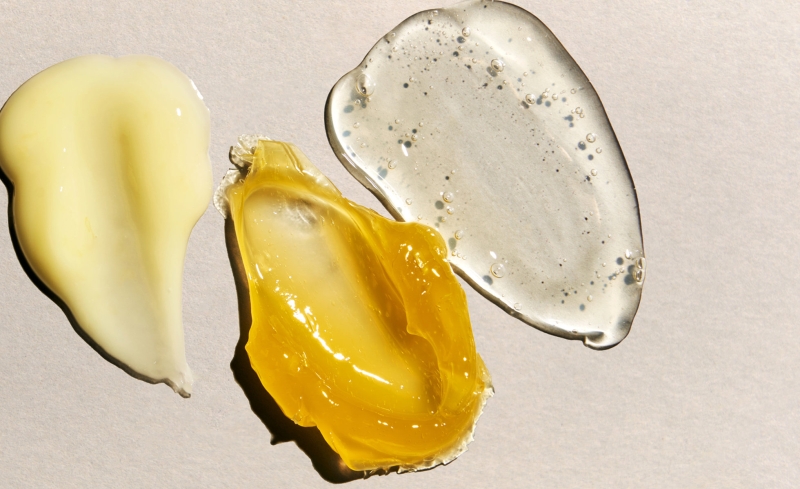Contents
If you’re building out a skincare routine to target a specific concern, you’ll find that certain ingredients are simply better together. And thankfully, no one needs a science degree to understand how some ingredient combinations can take the results to the next level.
Read on to learn how some of these popular active ingredients bring out the best in each other and how to incorporate them into a routine for best results.
Niacinamide and Ceramides
Why they work together:
Over the years, niacinamide has been a popular powerhouse ingredient for a laundry list of reasons: it helps to reduce transepidermal water loss (TEWL) and calms and hydrates every skin type.
This multipurpose ingredient is even more potent in a routine with ceramides. Together, these glow-boosting BFFs work to soothe all skin types, boost radiance, and support a healthy skin barrier. (Niacinamide also helps promote the skin’s natural production of ceramides.)
How to incorporate them:
For best results, use ceramides as the last step in your routine after niacinamide.
How often to pair them:
Ceramides and niacinamide are gentle enough to be used together twice daily.
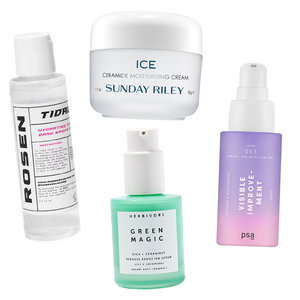
Beautylish Recommends:

- Herbivore Green Magic Cica + Ceramides Redness Reducing Serum, $48
- Rosen Skincare Acne-Fighting Tidal Toner with Silver Ions & Niacinamide, $20
- Sunday Riley Ice Ceramide Moisturizing Cream, $65
- PSA Visible Improvement: Peptides & Niacinamide Serum, $43
Salicylic Acid and Hyaluronic Acid
Why they work together:
Blemish-fighting salicylic acid is a beta hydroxy acid (BHA) that keeps pores clear of dead cells and sebum. Unfortunately, when applied too much or with sensitive skin, this chemical exfoliant can also lead to dryness, peeling, surface redness, and irritation.
That’s where hyaluronic acid can make all the difference. This water-based ingredient acts as a giant drink for your complexion (holding up to 1,000 times its molecular weight in H2O!), keeping skin smooth and hydrated, treating the look of surface redness, and even reducing scarring.
How to incorporate them:
Generally, it’s best to apply salicylic acid before hyaluronic acid to achieve maximum blemish-fighting efficacy and penetration.
How often to pair them:
Salicylic acid’s use frequency depends on your skin type. Textured skin may benefit from daily use, while sensitive skin may want to limit it to once or twice a week. Hyaluronic acid is gentle enough to be paired with salicylic acid whenever you apply it.
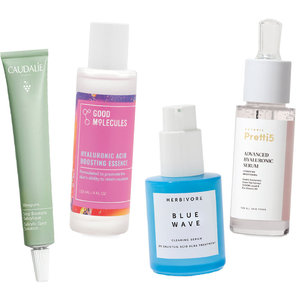
Beautylish Recommends:

- Herbivore Blue Wave 2% Salicylic Acid Acne Treatment, $48
- Caudalie Vinopure Salicylic Spot Solution, $25
- Good Molecules Hyaluronic Acid Boosting Essence, $14
- Pretti5 Advanced Hyaluronic Serum, $78
Vitamin C and Niacinamide
Why they work together:
Vitamin C has long been touted for its glow-boosting benefits, and there are many options to suit just about every skin type and concern. Once you choose the right one, incorporating it with niacinamide will bring even more radiant results.
Why? They’re both potent water-soluble antioxidants, with niacinamide working to rejuvenate and provide a protective barrier while vitamin C offers antibacterial benefits. This combination offers a brightening and anti-aging boost with fewer dark spots, discolorations, and fine lines.
How to incorporate them:
This depends on the products you incorporate. As a general rule, apply the product with a thinner formulation first. It’s also possible to find products that contain both ingredients.
How often to pair them:
These ingredients are fine for most skin types. If unsure, start with vitamin C in the morning and niacinamide in the evening.
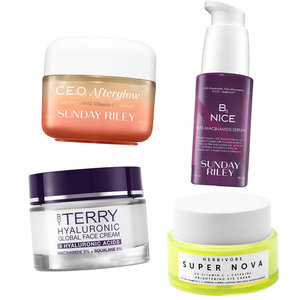
Beautylish Recommends:

- Sunday Riley C.E.O. Afterglow Brightening Vitamin C Cream, $65
- By Terry Hyaluronic Global Face Cream, $88
- Herbivore Super Nova 5% THD Vitamin C + Caffeine Brightening Eye Cream, $48
- Sunday Riley B3 Nice 10% Niacinamide Serum, $65
AHAs and BHAs
Why they work together:
Alpha-hydroxy acids (such as lactic and glycolic acids) work to chemically exfoliate and gently remove the top layer of dead surface cells for smoother, brighter skin. Similarly, beta-hydroxy acids (like salicylic acid) penetrate pores to dissolve dead skin cells and sebum buildup gently.
While they’re chemical exfoliants, AHAs and BHAs work differently but synergistically. Think of BHAs as the ingredient that does the deep digging, reaching deep into pores to reach the acne-causing dirt and debris to the surface. AHAs then act as the broom, sweeping it all away to even out your skin tone and keep your complexion looking clear and radiant. And because AHAs keep the skin’s surface clear, they also allow the BHAs to penetrate more effectively. Like we said, it’s skincare synergy.
How to incorporate them:
There are various ways to make this duo work for your routine. You can apply a BHA first, then follow up with an AHA. Or, you can apply the BHA in the morning and follow with an AHA in the evening (sans retinol). Either way, make sure to finish your morning routine with plenty of SPF.
How often to pair them:
When using chemical exfoliants, start slowly, pay attention to the strength, and listen to your skin. Depending on the product you select, follow the application instructions until you find the cadence that works best for you.

Beautylish Recommends:

- Sunday Riley Good Genes All-In-One Lactic Acid Treatment, $48
- Herbivore Prism AHA + BHA Glow Facial, $58
- Indie Lee AHA Exfoliating Solution, $52
- Holifrog Halo AHA + BHA Evening Serum, $58
Retinol and Hyaluronic Acid
Why they work together:
We love retinol for its clinically proven wrinkle-smoothing and skin-brightening superpowers. However, it can also be reactive and easily irritate the skin, especially when coupled with the wrong active ingredient.
Thankfully, hyaluronic acid is a match made in heaven when paired with retinol. This natural humectant helps the skin retain its much-needed moisture, so you’ll get all the anti-aging benefits of retinol minus the flaking and irritation.
How to incorporate them:
Apply retinol in your evening routine and wait around 20-30 minutes for the treatment to dry and soak into your skin. Then, apply a hyaluronic acid serum or moisturizer. If you have sensitive skin, you can apply hyaluronic acid before retinol—just make sure to apply a moisturizer once the retinol has dried.
How often to pair them:
You can use hyaluronic acid with retinol any time you apply retinol.
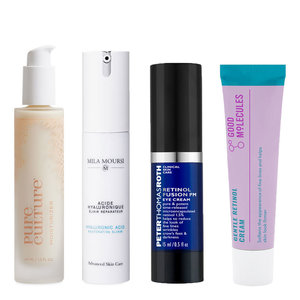
Beautylish Recommends:

- Peter Thomas Roth Retinol Fusion PM Eye Cream, $55
- Mila Moursi Hyaluronic Acid Restorative Elixir, $95
- Good Molecules Gentle Retinol Cream, $8
- Pure Culture Beauty Hyaluronic + Peptide Moisturizer, $34

